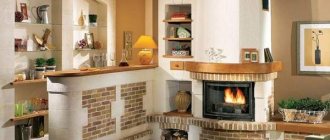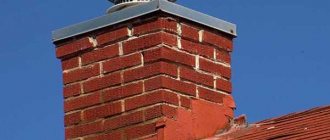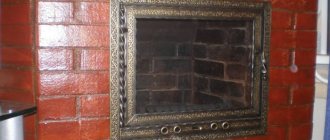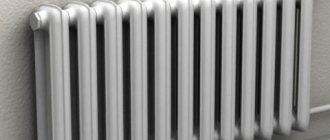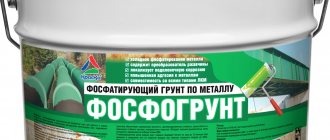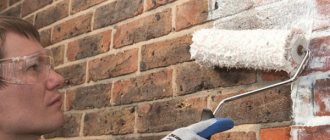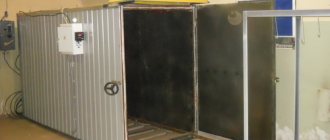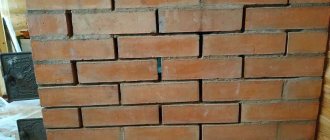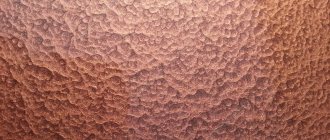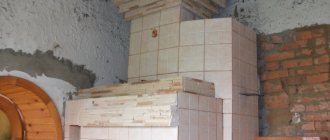What is heat-resistant paint?
The first thing worth noting is that fireproof metal paint for furnaces tolerates high temperatures of 100°C and above. Such coatings have an organosilicon base, which includes fillers, polymers, and coloring pigments that increase its heat-resistant properties.
In order for the paint for stoves to retain its properties for a long time and not be destroyed under the influence of high temperatures, special technology is used for its production. Enamel consists of organic radicals, silicon atoms, aluminum powder and oxygen. All these substances together protect the surface of the stoves from the negative effects of high temperatures, and thanks to organic resins, fire-resistant paint is elastic and quick-drying.
Almost all compositions intended for painting stove structures are made in the form of suspensions based on heat-resistant varnishes that contain silicone and silicon.
Absolutely all elements of the stove are painted, but a number of factors should be taken into account here. Small metal parts and large surfaces are painted with special types of paints that are used for very high temperature conditions. Such compositions are suitable not only for stove structures, but also for barbecues, where the metal is in very close contact with open fire.
Other heat-resistant metal paints for stoves are designed specifically for coating surfaces made of brick or trimmed with stone. Mixtures for those areas that are exposed to thermal stress must withstand heating of at least 350-400 ° C. Thus, even during the burning of ordinary paper, the temperature on its surface is +380-400°C. During an intense flame when burning wood, it reaches up to +400-450°C. It is clear that the degree of heating of the external surfaces is much lower than that of the firebox, but in any case, preference should be given to fire-resistant paint for the stove, which will cope well with heating from 400 to 550°C. Many manufacturers produce paints intended for various purposes, and temperature indicators are indicated on their packaging. That is why there are no difficulties in choosing the appropriate composition.
How to prepare a fireplace for painting?
Before you start painting, the structure must be properly prepared. Ignoring this procedure will lead to the fact that the paintwork will lie unevenly, quickly crack and peel off. Stages of preparing a fireplace for painting:
- Removing dust, dirt and cobwebs.
- Processing metal parts with sandpaper (it is better to use fine-grained sandpaper).
- Removing greasy stains. This should be done with a soft cloth soaked in saline solution.
- Removing soot with hydrochloric acid solution.
- Getting rid of rust. Rusted areas can be effectively cleaned with a rag moistened with a 10% solution of copper sulfate.
If the fireplace is made of brick of unsatisfactory quality, or there are significant defects on it, it should be plastered in 2 layers with a lime-gypsum or lime-clay composition, and walked over the plastered surface with coarse-grained and then fine-grained sandpaper. After this, the fireplace needs to be heated a little.
Varieties
Based on the maximum temperature that heat-resistant paint for stoves can withstand, the following types are distinguished:
- heat-resistant enamel for metal: the maximum temperature it can withstand is 80°C;
- acrylic and alkyd paint: its maximum is 100°C. It contains special pigments. After the enamel is applied to the surface, it does not turn yellow, its color does not fade or fade. Most often it is used to cover iron heaters in the bathhouse. This type is produced in the form of an aerosol, which is very convenient for coating;
- enamel made from epoxy, acrylic, polyurethane compounds with heat resistance up to 200°C;
- heat-resistant metal paint for furnaces with an ethyl silicate or epoxy ester base with metal powder, which tolerates high temperatures well - up to 400 ° C;
- silicone paint: zinc or aluminum powder is added to it: this type of coating can withstand temperatures up to 650°C. It is most often produced in the form of a spray.
Distinctive features of high-temperature paints
It is worth noting that heat-resistant paint for stoves and fireplaces is quite expensive. Many users, in order to save money, paint metal surfaces of structures with oil, enamel paints and water-based paints. However, it is worth knowing the peculiarities of the behavior of such mixtures when heated:
- For example, oil paint, which is made on the basis of drying oil, will initially soften, and at very high temperatures it will simply begin to burn. In any case, there will be a pungent burning smell in the room.
- Regular enamel will dry out and over time it will lose elasticity, which will lead to cracking and crumbling. This entire unpleasant process will be accompanied by an unpleasant aroma.
- Water-based paint, which is applied in a thick layer, in the process of evaporating moisture from it, will begin to crack and crumble in the shortest possible time, and many small cracks will appear on a thin layer.
After two or three firings of the stove or fireplace, ordinary paints will turn yellow. In addition, it should be remembered that rust will have a negative impact on them from the inside; it will corrode the paint and appear on the outside. Such compositions will not protect heated surfaces, and may even damage not only the walls and structural elements, because Acrid fumes have a very negative impact on human health.
Painting the fireplace after puttying
In addition, such a coating will not be enough even for one heating season, and after that the paint on the metal/bricks will remain in areas that will be very difficult to remove due to the high porosity of the material. Cleaning oil and enamel paint from brick is also very difficult, and under no circumstances should you paint over it, since in any case it will release harmful substances and negatively affect the renewed outer layer. To clean, you will have to use a wire brush or a sander with a special attachment.
Requirements for paints for stoves and fireplaces
When choosing heat-resistant paint, be sure to pay attention to a number of parameters:
- ability to withstand high temperatures well;
- resistance to aggressive environments;
- consumption per 1 m²;
- pay attention to the components that make up the dye;
- ease of paint application.
Heat-resistant paint and varnish compositions are divided based on the base component on which they are made:
- acrylic;
- silicon;
- silicone;
- epoxy resins.
The performance characteristics of the entire composition depend on the main component.
In order to make the right choice of heat-resistant enamel, it is necessary to take into account the type of surface that is being painted and its application. The paint can be used to paint bricks or stone near the fireplace, metal parts of stoves, heating boilers, barbecues, barbecues, etc.
You can find out which paint is best to use for painting batteries here
Enamel for non-ferrous and ferrous metals is a paint with various compositions. This point must be taken into account when choosing. For each individual type of surface, the composition of the enamel may be different; all information can be found on the packaging. Enamels that contain heat-resistant glass and composite materials have the highest heat resistance. For painting areas that are not exposed to high temperatures, any type of heat-resistant metal paint can be used, even with the lowest heat resistance ratings. When choosing enamel, be sure to take into account the fact whether the surface is primed before the procedure. This is due to the fact that not all materials are compatible with primer.
When choosing heat-resistant paint for brick stoves, it is important to consider the possibility of painting not only this material with enamel, but also concrete, wood, and plastic. The price of heat-resistant enamel can say a lot. Firstly, it speaks about the nature of the components used, and secondly, it indicates what level of temperature the paint can withstand. The price also reflects the container of the material and the type of mixture (liquid or aerosol).
When choosing enamel, special attention should be paid to the quality characteristics. The main thing is that the heat-resistant paint can withstand chemical exposure well and can protect metal products from rust. It is also very important that the substance does not emit harmful substances, and also tolerates temperature changes well. Water-based formulations are considered the safest.
It is also important to take into account the fact that one type of paint may not be enough, because... for metal parts you need one type, and for brick a completely different one. If the stove is both indoors and outdoors, you also need to use different types of enamel.
Painting a brick stove in a house
After reading the instructions and completing the preparatory work, the quality of which largely determines not only the final result, but also the service life of the coating, you can begin painting. If you do everything in accordance with the recommendations of the mixture manufacturer, then no difficulties should arise during the work. In addition to the coloring process, you will need the following:
- Container for coloring composition.
- The best tool to use is a paint brush and roller. You can use either one of them or in combination, it is only important to avoid smudges and stains, and also that the devices are new. When painting with a paint brush, it is possible to give the surface texture, and using a roller, it is possible to apply the mixture more evenly.
The process of painting the stove itself should be performed as follows:
- The first step, if necessary, is to dilute the mixture used in accordance with the manufacturer's recommendations.
- Then you can begin applying it to the stove surface using a brush or roller, avoiding smudges and other defects.
- When finished, you need to take a break and wait for the fresh coating to dry. Once this happens, the oven can be re-coated.
If, upon completion of hardening of the second layer, there are no areas where the brick is visible, then the work can be considered ready. Otherwise, the stove surface needs to be coated again.
After figuring out how to paint a brick stove in a house and the accompanying nuances, the observance of which allows you to do the job efficiently and avoid possible mistakes, you should purchase everything you need, and then you can start painting it yourself.
Video:
Features of paints for various surfaces
Paint for brick surfaces
The following requirements apply to heat-resistant paints for ovens:
- ability to withstand temperatures up to 300°C;
- resistance to steam and moisture, especially for stoves located in bathhouses;
- resistance to cracking and fading.
Organosilicon compounds, which include enamels KO-168, KO-8101, KO-813, etc., have all these properties.
For stoves and fireplaces made of brick installed in residential premises, an attractive appearance is a very important criterion, since such structures very often act as a decorative element.
For example, heat-resistant transparent varnish is applied to fireplaces or stoves that are decorated with artificial or natural stone.
Paint for metal surfaces
Recently, small-sized steel/cast iron stoves and fireplaces have become widely popular. They do not take up much space and are very neat in appearance.
Such devices, as well as metal elements of brick heating structures, require a special approach when choosing paint, since metals are susceptible to rust. That is why it is important to choose the appropriate composition. Another property of them is expansion under the influence of high temperatures; in addition, they can be destroyed by stray currents. In connection with all of the above, it is important that heat-resistant paint for metal products has the following properties:
- the paint must withstand temperatures up to 750°C;
- during heating, it should not emit harmful substances and unpleasant odors;
- it is very important that the composition is elastic and does not crack;
- high degree of anti-corrosion properties, thanks to which you can apply paint
- on areas that have not been cleaned of rust, without prior priming;
- must be resistant to processes due to which the material may fade or turn yellow;
- for stove structures that are installed outdoors, you need to choose a paint that, among other things, will also withstand negative temperature conditions well;
- Also, the paint should not be afraid of an aggressive external environment. It is very important that the composition has the ability to protect the product from moisture, water, and active chemical compounds.
All these qualities are inherent in heat-resistant enamel paints KO-8104, KO-811 and others.
Choosing a coloring agent for painting stove walls
Today, the construction market is represented by a wide selection of all kinds of dyes for decorating a brick oven. However, the following materials are considered key and advantageous:
Drying oil made from natural ingredients. Its characteristic property is that it does not change the brick color, but only makes the color darker. Before using it, the oven is heated very well. Before the processing process, it must work for at least 2 hours.
The varnish creates a transparent glossy layer, so it can perfectly transform the appearance of absolutely any stove. For this, a specially designed varnish of the PF-283 variety is used, mixed with turpentine in the same ratio. This composition creates a decorative decoration for the stove with high strength characteristics. An important quality of using varnish is adding dry gouache to its solution to create the desired shade.
Organosilicon enamel is distinguished by the highest chemical and technological properties: high adhesion to brick, strength and moisture resistance, long service life.- Heat-resistant paint, its key advantage is heat resistance with temperatures up to 550 C and the availability of a wide range of shades.
As is obvious, there is such a large selection of paint and varnish products on the building materials market that the master should not have the question of what to paint the stove with. You just need to know the characteristics of the stove and apply the successful experience of experienced stove makers.
Requirements for oven paint compositions
The oven is quite difficult to operate, since its surfaces are alternately located in cold and high temperature zones. Such a temperature difference has a destructive effect on the walls of the furnace, which often need to be treated with protective materials. In connection with this, paint for stove bricks must be resistant to high temperatures and temperature changes. In addition, different parts of the structure heat up unevenly. Metal parts heat up more, so they require the most heat-resistant composition.
Based on the level of resistance to high temperatures, paints are divided into fireproof/refractory, heat-resistant and heat-resistant.
The former tolerate temperatures up to 1800C. They have a high price and are practically not used in everyday life. Heat-resistant paints tolerate 600C – 1000C. Used for painting metal stove elements. To paint the furnace body elements, specialized heat-resistant paints are used that can withstand temperatures of 200-400C.
Additionally, the paint composition must meet the following indicators:
- Safety. When heated, treated surfaces should not release toxic elements. As a result, it is imperative to study the coloring composition before treating the brick surfaces of the oven with it.
- Thermal conductivity. The composition should not be an insulator and interfere with the heating of the premises, reducing the efficiency of the stove.
- Chemical resistance to withstand daily maintenance using detergents.
- Elasticity, guaranteeing resistance to sudden temperature changes, without causing the formation of cracks.
Technology of coating products with heat-resistant paint
The first thing you need to do before painting stoves is to thoroughly prepare the surface. This requirement cannot be neglected, since the quality of all work performed will depend on this stage. The sequence of actions is as follows:
- The stove must be thoroughly cleaned of any remnants of the old coating, various chemicals, oil traces, etc. Products can be coated with enamel under environmental conditions from +40°C to -15°C, and it is important that humidity standards are met.
- The next step is to clean the surface from rust until you see a metallic sheen. This procedure is performed using sandpaper or a drill with a brush attachment. Upon completion of the procedure, the surface should be thoroughly washed and dried.
- Next, you need to degrease the structure using a solvent. After the surface has been treated with a solvent, you need to wait 6 hours (if the work was carried out outdoors) and a day (if the entire list of procedures was carried out indoors). After this, you can begin to cover the surface with paint.
- The helmet must be applied in several layers and in different directions; the second layer can be covered only after the first has completely dried. It is important that the outer covering of the metal case is not wet. If after a short period of time you see that the paint begins to peel off, it means that the composition was chosen incorrectly for this material. Working with an aerosol is slightly different from painting with a brush. All the details are usually included in the instructions.
Manufacturers
Currently, specialized stores have a very large selection of heat-resistant paints and varnishes, which are produced by different manufacturing companies. Products are represented by a wide range of both Russian and foreign production. We have already described the most popular types of paints suitable for brick and metal products. Now let's look at their characteristics.
Enamel KO-8101
The heat resistance of this paint ranges from 400 to 800°C. It is considered universal, because It can be coated on different surfaces: brick, metal, concrete.
Heat-resistant anti-corrosion enamel KO-8101
For metal products, experts advise purchasing the anti-corrosion compound KO-8101. Before coating, it is not necessary to carry out preparatory procedures. When heated, such paint does not form any harmful fumes, so it is considered an absolutely safe product. A very important advantage of this composition is the fact that you can work with it even at sub-zero temperatures. Such paints are characterized by high protection rates and a wide variety of colors, so everyone will find an option here to their liking. The manufacturer provides a guarantee for its products for a period of 15 years.
This type of paint is produced by many domestic and European companies, “Termika”, “Karst” and others.
All manufacturers use the same manufacturing technology. Only the color scheme may differ.
Solvents used to create paint are xylene and toluene.
The composition consumption for a three-layer surface coating is 120÷240 g/m². The drying period of the coating at a temperature of 150±2 °C is no more than half an hour, at 20±2 °C - no more than two hours. This enamel can be applied by spraying using a spray gun, or manually - with a roller or brush, in 2-3 layers, with each layer drying for 0.5 to 2 hours, depending on the ambient temperature.
Enamel KO-811
Heat-resistant enamel KO 811
This heat-resistant enamel is used for painting steel, cast iron, titanium surfaces, the heating temperature of which can reach 400°C. The paint looks like a suspension, which contains pigments dissolved in silicone varnish.
Usually KO-811 is sprayed. To do this, the enamel must be diluted with a stabilizer 100:6 for white paint and 100:7 for other colors. The mixing process takes place shortly before application.
The finished composition must be consumed within 24 hours.
The enamel coating must be well cleaned of dirt and grease. In order to rid the surface of all these traces, solvents are used.
The solvents used for this enamel are R-5A, toluene and xylene. The paint can be diluted: KO-811 by 30÷40%, KO-811K (white) by 70÷80%, other colors by 40÷50%. Enamel consumption varies from 100 to 250 g/m², depending on the color. The drying time of the painted surface at temperatures of 200, 150 and 20 degrees is no more than 2 hours. This heat-resistant paint is produced by Termika, NPF Emal LLC and other companies.
Enamel KO-168
KO-168 enamel with silicone varnish
This type of composition is intended for use at temperatures not exceeding 150°C. This means that this enamel can be used to cover brick products and metal parts that are located at a sufficient distance from the firebox. The functions of this enamel are not only protective, but also decorative. Manufacturers offer various colors of KO-168 enamel.
Subject to all operating requirements, such a composition will act as excellent protection for any material. This is due to the fact that such a coating is characterized by high moisture resistance and frost resistance. In addition, it is not afraid of exposure to ultraviolet rays, which means the enamel will retain its original shade for a long time.
KO-168 enamel is also a suspension containing pigments, fillers and additives mixed with silicone varnish. Paint consumption depends on the chosen color: for red and white enamel – 150 g/m²; for yellow – 180 g/m²; for blue – 140 g/m²; for brown, blue, light green, beige – 130 g/m²; for green – 120 g/m²; for black – 80 g/m².
KO-168 enamel is produced in ready-to-use form. If it is necessary to dilute it, toluene or xylene solvents are used. The drying time of enamel at a temperature of 20 ± 2 °C is about a day. If a metal surface is to be painted, it must be cleaned of various contaminants and degreased - also with xylene, solvent or acetone, and then the surface is wiped dry. Painting with this composition can be carried out at air temperatures from -30 to +40 degrees.
Heat-resistant paints "Tikkurila"
Heat-resistant paint Tikkurila Termal black
Tikkurila is a famous company from Finland, whose main specialization is the production of various paints and varnishes. The company's product range includes black and silver shades.
Silver enamel consists of varnish and aluminum powder. This mixture is designed to be heated up to 900°C; therefore, it can be used for painting metal surfaces. You can coat stoves that are located both in the house and on the property with this paint. This is due to the fact that Tikkurila paint tolerates environmental influences well.
Black paint is only suitable for surfaces heated to 400°C. The composition is applied by spraying or manually with a brush.
Enamel "Certa"
Certa heat-resistant enamel up to 700°C
Certa is a domestic manufacturer that produces heat-resistant paint for metal structures, since the composition is characterized by high anti-corrosion properties.
The paint well protects both individual parts of the structure and the entire product from moisture, overheating and aggressive influences. Temperature range - -60°С - +90°С. The composition, which is available in cans, is applied with a brush, and in aerosol cans it is sprayed.
Can the stove be painted?
One of the modern trends in interior design is decorating residential premises with objects made of natural stone or brick that perform a purely decorative function or have a functional purpose. The natural appearance and original structure of these materials look unusual and original. A similar technique is often used in the construction and cladding of fireplaces. The combination of rough brickwork and live flames looks especially beautiful.
Ordinary red brick is inexpensive, but is not always of high quality. To hide flaws in the brickwork and prevent its destruction, they resort to painting. Painting makes the fireplace more well-maintained and makes imperfections invisible. If you choose expensive and high-quality material to build a fireplace, this still will not save you from the need to paint it, since any material during operation at high temperatures eventually loses its original appearance and is destroyed.
Reasons why experienced professionals recommend painting brick fireplaces:
- protection from destruction;
- additional strengthening of the device;
- giving the structure a beautiful appearance and the brick surface a more saturated shade;
- masking minor defects in masonry and material;
- improving the vapor permeability of bricks;
- increasing the service life of the heat generator furnace;
- creating a moisture-repellent coating.
The choice of paintwork materials for painting this attribute is an important point. When purchasing paint, you must carefully study its composition and properties, since the fireplace is used under special conditions. If you don’t want or have the opportunity to spend money on an expensive coloring agent, you can simply whitewash the heat generator itself. Whitewashing is a way to decorate a brick fireplace on a budget and in an original way.
If the structure in question is not just a piece of furniture, but is also used for its intended purpose, it cannot be painted with the first paint that comes to hand. The fireplace is exposed to high temperatures, so the paintwork must first of all be resistant to fire, otherwise the coating will quickly crack and begin to bubble.
The outer surface can warm up to 90°C. Not every paint can withstand such a high temperature. If the structure is built according to all the rules, it must transfer at least half of its heat to the room. In addition, the efficiency of the heater largely depends on the type of coloring composition with which the fireplace is coated. A smooth surface has worse heat transfer than a rough surface, so it is better to avoid using aluminum paint and its analogues.
Another important point is the color of the paintwork material. The darker it is, the more intense the heat transfer will be. Among other things, the coloring composition should not emit harmful substances, since fireplaces are usually located in residential areas. All these nuances must be taken into account when purchasing paint, otherwise the result will not live up to expectations.
| Types of coloring compositions | General information | Marking options | Decoding |
| Alkyd | Designed for painting surfaces heated to 100°. They have a pungent odor, make it possible to create a coating that is not very durable, and do not withstand thermal expansion of the base well. | KO-811 | Paint marked in this way is intended for coating metal elements, stone and brick. It is resistant to sudden temperature changes, and when heated, its coating becomes more durable. |
| Heat resistant acrylic | Penetrating deeply into the pores of the material, they create a durable film on its surface. They have a wide range of colors. | KO-813 | Paintwork materials with this marking are used for painting stoves and fireplaces installed in dry or damp rooms. Thanks to the content of aluminum powder, they can withstand temperatures up to 500 degrees. They have antiseptic and anti-corrosion properties. |
| Organosilicon | Suitable for painting all types of heat generator stoves, regardless of whether they are located indoors or outdoors. They have an affordable price, high adhesive ability, strength, moisture and heat resistance, durability, and elasticity. They have a small range of colors. | KO-8111 | Paints marked in this way are the most heat-resistant. They can withstand temperatures over 600°. |
| Brand of coatings | Color | Shine | Maximum temperature, degrees | Packing |
| Elcon (varnish) | Transparent | Matte/semi-gloss | 250 | Spray can, jar |
| Elcon (paint) | 250 shades | 250–1000 | Spray can, jar, bucket | |
| Rust-Oleum Specialty High Heat | Transparent, black, aluminum | Matte | 1090 | Spray can |
| Motip | Transparent | 650 | ||
| Decorix | Glossy | 250 |
You can cheaply paint a heat generator stove with your own hands using the so-called grandfather’s methods: lime, chalk, clay, homemade coloring agents. These methods have long been used to improve village stoves. A whitewashed or clay-covered fireplace in modern homes looks at least strange, but in an antique-style house or country house such a design will fit perfectly into the overall interior.
| Budget options for coloring products | Preparation | Ways to change color | Application Tools | Subtleties of use |
| Lime | Dilute 1 kg of quicklime in 1.5 liters of cold water. | Add artificial dye, brilliant blue or manganese to the finished product. | Wide brush or roller. | Apply in several layers, no need to wait for each of the previous ones to dry. |
| Chalk | Pour the crushed chalk into powder with water. Let the mixture sit for 2-3 hours. Dilute 100 g of carpentry or casein glue in 10 liters of water. Combine the infused chalk solution with glue. | Subsequent layers are applied only after the previous ones have completely dried. | ||
| Clay | Dilute the clay with water to the consistency of liquid sour cream. | — | Apply in one layer. | |
| Homemade paints | Mix varnish PF-283 with solvent or turpentine. | Subsequent layers are applied only after the previous ones have completely dried. |
You can paint with any tool. It is convenient for some to do this with a brush, perhaps with a roller. When using a roller, it must be taken into account that a characteristic pattern will remain on the surface to be painted. During work, you should move only in one direction - from top to bottom. If the structure consists of brick and metal parts, first its body, i.e. the chimney, is painted. To prevent paint from accidentally getting onto the areas near the door, they must be sealed with tape.
It is possible to paint a brick oven; moreover, it is advisable to do this before the start of operation. This is done not only for aesthetic reasons. Untreated brick has a porous structure and, like a sponge, absorbs grease, soot and other contaminants. The resulting stains cannot be washed off without damaging the brick.
Paint or varnish applied to brickwork seals pores and microcracks. After the paint mixture has completely dried, a dense layer is formed that protects the brick from dampness and dirt, and also makes it easier to maintain the stove. Some modern paints contain additional components, for example, antifungal or anti-corrosion.
Old brick oven
- condition of the stove (new, old);
- operating mode (constant, periodic);
- likelihood of contact with water (living premises, bathhouse);
- surrounding interior (style, color scheme).
We invite you to familiarize yourself with: Pool filter connection diagram
For example, it is more advisable to emphasize the beauty of new brickwork without a single flaw using a transparent coating (drying oil, varnish). An old stove that has defects or has been damaged by dampness can be painted with paint of the desired color.
Different types of paint
To paint a stove in a house or country house, you need to use a special type of paint. They are called heat-resistant because they retain their structure even under high heat. Heat-resistant paints are divided into several groups:
- low heat resistance (80–100°C);
- medium heat resistance (120–200°C);
- high heat resistance (400–650°C).
Only paints with high heat resistance are suitable for coating ovens. Stove masters recommend combining different types of paints when painting different elements of the stove. This allows you to get high-quality results without unnecessary expenses.
The main part of the stove, made of brick, can be painted with Ecoretta paint or Thermolux antifungal paint. For metal parts of the stove (doors, dampers), it is recommended to use paints of the Certa, Dali, and Celsit-500 brands. These materials, in addition to high heat resistance, have anti-corrosion properties.
Drying oil and varnish
Drying oil is suitable for those who want to preserve the original appearance and texture of brickwork. As a rule, new stoves that do not have defects are coated with drying oil. Drying oil is distributed with horizontal movements over the surface of each brick.
Benefits of drying oil:
- has a natural composition;
- does not contain toxic substances;
- allows you to emphasize the pristine beauty of brickwork.
Flaws:
- limited heat resistance (stoves coated with drying oil can only be used for a few hours);
- does not protect masonry joints.
Popular types of oven varnishes today are heat-resistant silicone varnishes (KO-85, KO-815, Siltek-1). They provide reliable protection for bricks and seams, adhere well to the surface, and withstand prolonged heating and temperature changes. The disadvantages of this group of varnishes are the presence of acetone and other toxic substances in the composition, and a pungent odor at the time of application. However, completely dried varnish does not smell even when heated and is absolutely safe for the inhabitants of the house.
Apply the varnish to a clean, dry surface of brick and metal parts using a brush or spray in 2-3 layers with intermediate drying for 20 minutes. Drying time is 30 minutes. The varnish contains the flammable substance acetone, so it should not be used near an open flame.
